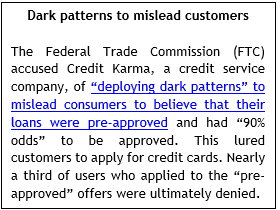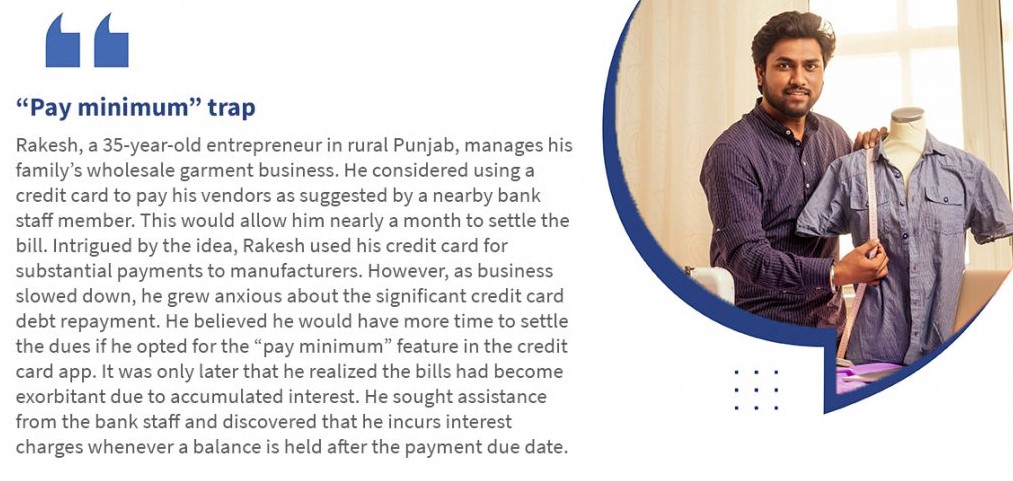The hidden cost of financial services in India
by Arshi Aadil and Gayatri Pandey
Nov 24, 2023
6 min
This blog discusses hidden pricing tactics that hinder digital financial services (DFS) adoption by low- and moderate-income (LMI) users. It also emphasizes why financial regulatory authorities must promote transparency and accountability in financial services.
Radha is a 28-year-old homemaker in rural Uttar Pradesh, India. She opened a bank account three years ago based on her husband’s suggestion. Yet she later discovered unexplained deductions. Her account was enrolled in government insurance programs without her knowledge. She stopped using her account as she felt she had little control over her hard-earned money.
Many people like Radha are unaware of financial products and associated terms. This is especially true for low- and moderate-income customers with limited literacy, who are largely “oral” and rely more on word of mouth. Some financial products may seem attractive upfront, but hidden costs in the fine print can erode trust and hinder informed financial choices.
Consumers struggle to compare options and assess financial products’ true value. They are often enticed by low initial fees and left in the dark about hidden costs. This limited knowledge can lead to hasty and uninformed financial choices by customers. As a result, their long-term financial health suffers.
Deceptive designs and hidden pricing techniques commonly used by some financial service providers include:
1. Bundled products and services with the bank account: Most banks bundle insurance programs, such as Pradhan Mantri Suraksha Bima Yojana (PMSBY) and Pradhan Mantri Jeevan Jyoti Bima Yojana (PMJJBY) with accounts. This is done without the customers’ awareness of product features or their consent to bundle the services. The LMI customers usually realize it later when they see unexplained deductions from their bank accounts. Most people do not claim benefits as they do not know enough about the product, even when they are eligible and genuinely need them. Since the inception of the PMJJBY and PMSBY programs, only around 0.7 million families out of the 500 million or so enrolled have claimed benefits. Since customers are charged the program’s annual premiums without their informed consent, their trust in the digital financial services ecosystem declines.
2. Account maintenance fees: Banks often advertise free or low-cost savings accounts that may have hidden maintenance fees triggered by factors, such as minimum balance requirements, transaction limits, or inactivity. In India, public and private banks’ average minimum balance requirements range from USD 6 to USD 60 (INR 500-5,000). An account maintenance charge or minimum balance requirement is not inherently wrong, even if it is almost universally unpopular. Yet, banks must ensure that every customer is informed about these policies during the account opening process.
3. ATM subscription and usage fees: Per the RBI guidelines, most banks offer five free withdrawals at their ATMs and three free withdrawals at an out-of-network ATM every month. Any usage beyond these permissible limits is chargeable. After these free withdrawals, the big brick-and-mortar banks charge customers an average of INR 25 (USD 0.25) per transaction for withdrawals from a non-network ATM. However, many customers do not know of such limits and pay fees for ATM withdrawals. All major Indian banks also charge an annual fee to use debit or ATM cards. Yet, customers are not always informed upfront about subscription fees and other processing charges. While the bank websites include information about ATM withdrawal charges in their FAQs, customers often lack a detailed explanation of these terms and conditions, especially when they open their accounts online.
4. Fine print and terms: Financial products, such as loans, insurance, and credit cards, often come with lengthy terms and conditions that contain hidden pricing. For instance, credit card companies offer attractive introductory rates, which increase significantly after the introductory period. Similarly, loans may have hidden fees for early repayment or penalties for late payments. Around two-thirds of banking customers do not fully understand their DFS’s terms and conditions.

Similarly, “buy now, pay later” (BNPL) extends credit to many consumers who lack access to credit cards. Such payment options incur a higher cost, from 2-6% of the total transaction value, and lead to consumer debt. It often pushes people to buy more items than they can afford, although most consumers see BNPL as a consumer-friendly financial solution. An additional concern is that customers may not grasp the BNPL terms. This may lead to overlooked or delayed payments. A study found that 30% of BNPL users struggled with missed payments, which led to late fees, strained their finances, and harmed their credit scores.
Many others, such as Radha and Rakesh, have fallen prey to hidden pricing associated with digital financial services. This has gradually eroded customers’ trust in the financial ecosystem.
Protecting consumers—a clarion call for policymakers, regulators, and financial service providers: Consumer protection is crucial to ensure transparency and fairness. Policymakers or regulators must implement the following measures to ensure consumers are well-informed before they make financial decisions:
a. Responsible selling through adherence to regulations and compliance: Governments and regulators should mandate financial service providers to summarize essential product details, such as pricing, fees, and terms, in a clear, transparent, and client-friendly manner. They should provide customers with comprehensive information on risks and costs associated with the product. Financial service providers must dedicate a section of their website to customer rights and compensation processes for monetary or non-monetary loss due to implicit consent and ambiguous terms and conditions.
b. Use of standardized templates for easy monitoring: Regulators should conduct audits and market studies and oversee compliance with disclosure rules and consumer protection regulations. They can create uniform templates for financial service providers to ensure the information presented is consistent and clear. These templates would also help in monitoring and evaluation. It would thus allow customers to compare different offerings and make informed choices. Regulators should analyze specific harms posed to vulnerable consumers through market monitoring tools and provide regulatory solutions to mitigate them. For instance, FSD Kenya and Princeton University collected and analyzed tweets relevant to consumer protection and directed toward 29 different financial institutions in Kenya. Otoritas Jasa Keuangan (OJK), Indonesia’s financial services authority, started an initiative to upgrade its consumer protection practices. OJK worked with MSC to develop a chatbot and a consumer protection portal, Aplikasi Portal Perlindungan Konsumen (APPK). Both enabled quick and automated registrations to process these complaints efficiently. The chatbot channel and email response system received an average of 51,000 complaints monthly.
c. Promote technology and innovation for customer education: Customers’ education on financial products, services, and associated costs is essential. Technology, such as financial apps and tools, can enhance customer awareness, help them monitor their financial activities, and facilitate recourse in case of discrepancies. Countries such as China, Colombia, and Singapore have created platforms to encourage data sharing under regulated conditions to help consumers monitor their financial activities and facilitate recourse if they feel deceived. In July 2020, Bangko Sentral ng Pilipinas (BSP) launched a consumer assistance chatbot, BSP Online Buddy. It allows consumers to file complaints against BSP-supervised financial institutions through simple chat messages. It provides a convenient and user-friendly platform for consumers to seek resolution.
d. Publish transparency reports: The International Monetary Fund (IMF) has crafted a Central Bank Transparency Code (CBTC). It emphasizes the need for heightened transparency and accountability to uphold public backing for central banks and their stakeholders. IMF successfully piloted the first evaluations through its CBTC and reported that some banks, such as the Bank of Canada and the Central Bank of Chile, have already changed their frameworks. This is crucial to preserve independence and bolster policy effectiveness. Similar efforts by regulators can enhance transparency among financial services. Regulators should mandate publishing transparency reports on hidden pricing and corresponding compensatory actions taken by financial service providers. These reports should have the number of complaints lodged in the bank’s system and with the ombudsperson and the bank’s comprehensive response to each registered complaint.
Such recommendations can protect consumers from financial products and services with unclear terms, such as hidden fees, to enhance consumer trust in the financial system.
Written by

Arshi Aadil
Senior Manager
 by
by  Nov 24, 2023
Nov 24, 2023 6 min
6 min 
Leave comments